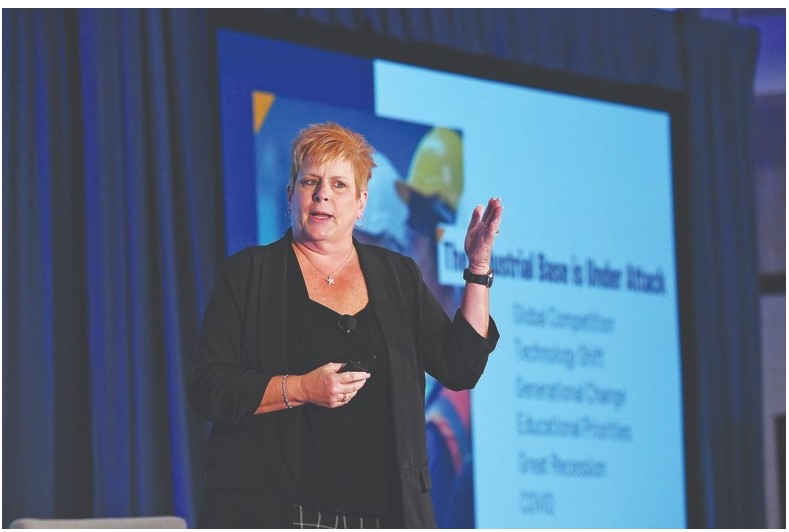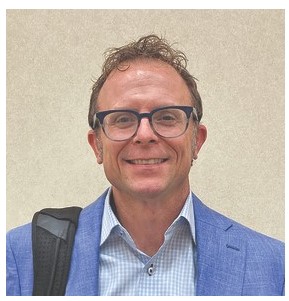Diligence, knowledge key for injection molders in uncertain markets
main text
Diligence, knowledge key for injection molders in uncertain markets

Michael A. Marcotte
Laurie Harbour, principal at consulting firm Wipfli, at the Plastics News Executive Forum 2024.
During a soft automotive market, injection molders should be diligent in evaluating the true cost of product lines and rightsizing their businesses, experts say.
With high interest rates, a tough economy and an upcoming U.S. presidential election, consumers are waiting to see if a new car purchase is "an investment they want to make right now," Laurie Harbour, principal at consulting firm Wipfli, told Plastics News.
Although the auto market is "not bad, … OEMs are still making good money," Harbour said, but it's "a softer market than what we would have ever expected pre-COVID. We're not at the 17 million-unit mark, and I don't think we will be for many years to come, if at all."
With consumer debt soaring and vehicle prices remaining high, consumers are waiting to see if the Federal Reserve Board lowers interest rates, and car dealership inventories are growing, she said.
"I never thought we'd go back to During a soft automotive market, injection molders should be diligent in evaluating the true cost of product lines and rightsizing their businesses, experts say.
With high interest rates, a tough economy and an upcoming U.S. presidential election, consumers are waiting to see if a new car purchase is "an investment they want to make right now," Laurie Harbour, principal at consulting firm Wipfli, told Plastics News.
Although the auto market is "not bad, … OEMs are still making good money," Harbour said, but it's "a softer market than what we would have ever expected pre-COVID. We're not at the 17 million-unit mark, and I don't think we will be for many years to come, if at all."
With consumer debt soaring and vehicle prices remaining high, consumers are waiting to see if the Federal Reserve Board lowers interest rates, and car dealership inventories are growing, she said.
"I never thought we'd go back to these days of 100 days of inventory, but we have," Harbour said. "I thought COVID taught us some things. Prices have kind of leveled off, but incentives are growing at the dealer. … I think this softness will continue through the balance of the year."
Market "softness," she added, is "creating a level of uncertainty" in the market. "It's still a better industry than some others, but [suppliers] have to be diligent."
EV slowdown ‘gridlocks' supply chain
Automakers have also "taken about a five-year slowdown on the implementation of electric vehicles," Harbour said.
"It's related to the economy and the price of vehicles and the lack of infrastructure in place to charge these products," she said.
The EV market is past the "apex of early adopters," she said. "Now we need things like cost to come down."
OEMs have slowed launches of new vehicle products by 12-24 months, directly affecting suppliers already selected for those programs, Harbour said, adding that the supply chain is "gridlocked" as carmakers stall the release of data needed by suppliers to start up design and production of components.
"All of the OEMs are stepping back and revisiting their strategies on BEV," Harbour said. "That makes them revisit their ICE strategy … [and hybrid vehicles] to get people more excited about electric vehicles.
"[OEM] engineering may not be ready with the design of the product or all the necessary milestones … [while a molder] is sitting there with engineers ready to start designing and processing that component," she said. "A big molder has 10-20 programs going all at once. … If 50 percent of them are on hold or delayed in redesign … then they're not full.
"Engineers are sitting there not able to capitalize on their capacity. Then [projects] all bottleneck … and then they release at the same time, those people can't manage everything," Harbour said. "It's chaos, internally. … Cadence is key."
Stalled volumes force companies to ‘rightsize'
Some Tier 1 suppliers have begun to lay off production workers because volumes have not grown at the expected pace, Harbour said. Amid the COVID pandemic, "companies kept people because it was so hard to find [skilled labor]."
"In many cases, [larger Tier 1 companies are] publicly traded and more diverse … so they tend to have some ability to flex," she said. "But on a plant-by-plant level … it depends on what programs they're on. It's easier as a big company to kind of get fat in some production areas. … They're not all as healthy as they can be. If they haven't done all their rightsizing, they'll struggle too.
"Some [injection molders] are proactively working to improve their business, and others are, frankly, not doing much of anything," Harbour said. "With volumes not returning to where we expected them and programs being start-and-stop, at some point you have to rightsize your business."
Injection molders need to put "moderate" plans in place to catch overspending and reduce debt, general administration costs, including "everything from supplies to travel" and employees in finance, HR, and other selling, general and administrative expense functions, she said. "A good company should be doing that every month anyway.
"At the end of the day, it's about the strength of their balance sheet and their ability to flex down and still make money," she said, adding that 25-35 percent of Tier 2 automotive suppliers are "struggling because they don't have clear balance sheets."
Some injection molders are "not taking seriously what they need to do in today's environment," Harbour said. "We can't bury our head in the sand [and] … say, 'It's coming back; we'll be fine.' We need the data to tell us the story."

Morgan
‘True cost" of manufacturing components
Injection molders that can't manage to find the "true cost" of manufacturing their product mix will likely end up victims of the market's continued consolidation, Ted Morgan, partner at advisory firm Plante Moran, told PN in an interview.
"There's this entrepreneurial spirit within the average custom injection molder, to say, 'We'll get the business and figure it out later,'" Morgan said. "This is a very hard industry. The stakes are very high to take those leaps of faith."
That entrepreneurial spirit can cause injection molders to "underbid" the cost to make a product line, he added.
"A growing number of plastics injection molders in automotive [have a] product mix [that] isn't where they need it to be," Morgan said. "It sounds so obvious, but injection molders have to know what it costs to make their parts.
"With interest rates where they are and the cost of capital where it is … you can't afford to have low-margin business," he said. "The average injection molder under-costs high-complexity, low-volume products," like components for EVs, which are "a more difficult production rate to manage."
The market slowdown on EV implementation is causing operational complexity for suppliers in the space, Morgan said, "unraveling" production schedules with unpredictable volumes.
"If you're getting a call from [customers] every day [with] … revisions of a certain part … that volatility … the higher the level of complexity, the more expensive it is on your indirect labor," he said.
"The total cost to make a product is well beyond the cost of the injection molding process. There's so much that happens before and after the molding that adds to your total cost."
That total manufacturing cost of a component can also vary between customers, Morgan said.
"This is not rocket science. But it comes down to being very mindful and understanding … [of] the cost to serve the customer," he said.
Investment in automation, efficiency
As automation becomes more affordable, plastic injection molders of any size have opportunities to integrate automation into their operations, he said, adding that suppliers are contemplating how much to invest in new equipment and still get a return amid high interest rates.
"The No. 1 way" for suppliers to control costs is though evaluating labor, Morgan said. "The benefits of automation continue to grow. … The industry has been saying this for 25 years.
"The carrot is definitely there to invest in newer equipment," he said. "[New injection molding presses are] more efficient and going to save money compared to older equipment.
"Machine manufacturers are good about trying to drive more efficiency in the cost to run their machines," Morgan said. "There are efficiencies to be gained. … The challenge is they're really expensive, and interest rates are high. It has a big impact on [suppliers' ability to upgrade].
"The more things change, the more things stay the same. You have to be really good to make money as an injection molder."
The firm is beginning to see a "trend of some distress in some challenged suppliers," Morgan said, which he expects to continue "at a reasonable pace" throughout the next five to 10 years.
Tier 1 or stronger Tier 2 companies may need to "rescue" smaller companies experiencing most of the stress on the market through acquisition, he added. "The injection molders that will remain are going to be really strong. … But there will be [fewer] automotive molders in the future than there are today."
* Source : https://www.plasticsnews.com/news/top-injection-molders-ranking-injection-molders-uncertain-markets
* Edit : HANDLER
